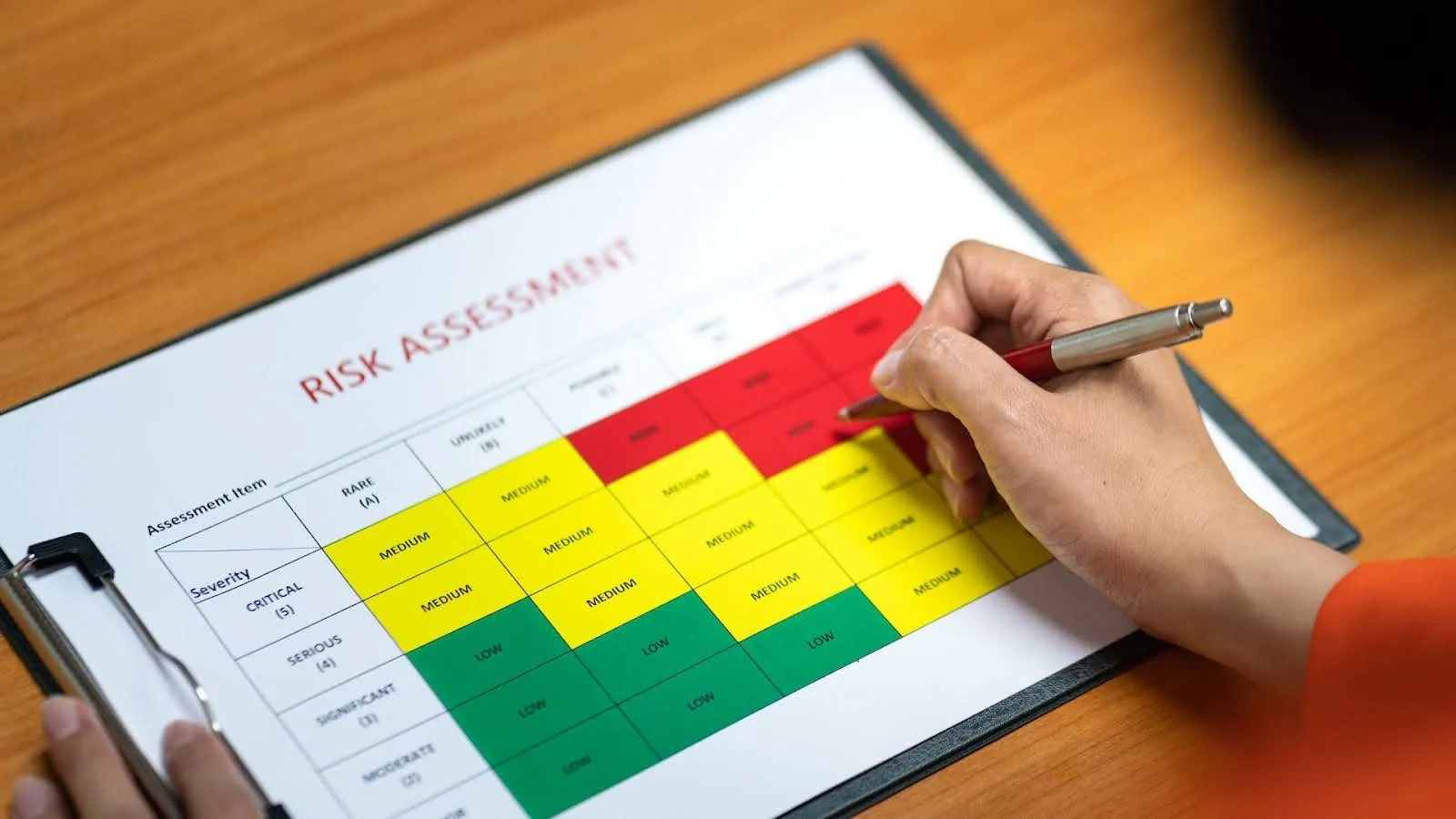May 21, 2025
Key Steps in Compliance Risk Assessment

By Fraxtional LLC

The compliance landscape has shifted from reactive checklists to a proactive, enterprise-critical strategy. In today’s regulatory climate, failing to meet compliance obligations isn’t just risky; it’s financially and operationally unsustainable.
Financial crime compliance costs have surged to $45 billion in the Asia-Pacific region alone, with 98% of institutions reporting rising expenses, signaling the urgent need for scalable and resilient programs.
Some regulatory breaches now cost companies over $14.8 million. These escalating risks demand compliance systems that are not only robust but also scalable and responsive to growing complexity.
Implementing adaptive compliance programs has become a strategic necessity for fintech, banks, and crypto platforms. At the core of that transformation lies the compliance risk assessment. This foundational process enables organizations to identify, evaluate, and prioritize regulatory exposure with precision.
With data breaches averaging $4.45 million, integrating compliance into your operational blueprint is no longer a legal formality; it’s a critical risk-reduction and growth enabler.
This article outlines the essential steps to conducting a thorough compliance risk assessment. It will help you safeguard your company against costly regulatory violations and build a stronger, more resilient compliance framework.
Step 1: Establish Strategic Scope and Objectives

Initiating a compliance risk assessment requires strategic clarity from the outset. Defining the scope and objectives ensures that your assessment remains focused, actionable, and aligned with organizational priorities across departments and regulatory domains.
Align Regulatory Expectations with Business Priorities
Effective compliance begins with a clear understanding of the regulatory landscape. Your obligations vary based on industry, geography, and operational model. Identify all applicable laws, standards, and enforcement guidelines relevant to your jurisdiction and business units.
Map these regulatory requirements against departments, systems, and processes. This creates a traceable link between the rules you must follow and the operational areas they affect.
In parallel, establish why this assessment is being conducted now. Is it driven by a new regulation, a recent audit finding, or part of a recurring internal review? Clarifying the context ensures that the risk assessment reflects current business realities.
Set specific objectives that go beyond vague mandates. Replace generic statements like "enhance compliance" with measurable goals, such as reducing audit preparation time by 20% or ensuring GDPR readiness across all business units.
Strategic alignment is critical. A mature compliance framework integrates legal requirements with broader business objectives by:
- Mapping regulatory demands to operational priorities.
- Engaging leadership early in compliance planning.
- Establishing KPIs that evaluate compliance impact and business value.
When business goals and regulatory requirements are connected, compliance shifts from overhead to strategic advantage. It improves decision-making, strengthens governance, and enhances enterprise resilience.
Form an Integrated Compliance and Risk Working Group
Regulatory risk is rarely confined to a single department. To execute a comprehensive assessment, input is required from multiple functions across the organization.
A cross-functional team enhances operational visibility and ensures domain-specific expertise. Involve compliance, risk leads, and stakeholders from IT, legal, finance, HR, and business operations.
Each function brings a distinct perspective:
- HR monitors employee certifications and onboarding practices.
- Payroll ensures statutory tax obligations are met.
- Finance evaluates the budgetary implications of compliance controls.
This collaborative structure broadens risk discovery and strengthens overall coverage.
Coordination also helps prevent process duplication. When departments operate in silos, they often create parallel procedures that undermine consistency. Standardizing risk models and documentation supports cohesive, board-ready reporting.
When compliance is embedded into core operations, it evolves from a policing role to a strategic function, driving governance, enabling transparency, and reinforcing organizational resilience.
With the right structure in place, the next logical step is to identify and analyze the specific compliance risks that could impact the organization’s operations, reputation, or regulatory standing.
Step 2: Identify and Analyze Compliance Risks

With your scope defined and team assembled, the next step is identifying and assessing compliance risks that could impact operations, financial stability, or regulatory obligations. This involves mapping risks across functions, evaluating exposure levels, and determining the likelihood and consequences of non-compliance.
Map Business Processes to Regulatory Touchpoints
Begin by mapping all critical business processes against relevant regulatory frameworks. This step establishes a clear baseline of your compliance obligations across jurisdictions and operational domains.
Many institutions use a rule register to consolidate applicable laws, regulations, and standards. This register is a reference point for compliance activities and ensures traceability of requirements.
Next, identify process flows, systems, and decision points directly interacting with regulatory mandates. Evaluate how these operational components are structured, monitored, and documented.
This is particularly crucial in high-risk areas like KYC frameworks in commercial banking, where evolving expectations require tight alignment between customer onboarding workflows and regulatory mandates
This exercise highlights high-risk areas, such as manual workflows, fragmented systems, or inadequate audit trails, that could lead to regulatory breaches. Addressing these vulnerabilities early allows you to implement targeted controls and reduce exposure before formal audits or enforcement actions arise.
Systematically Identify Compliance Risks Through Targeted Data Collection
Accurate compliance risk identification starts with disciplined data collection. Structured approaches are widely recognized for enhancing the identification of compliance risks. For instance, the National Institute of Standards and Technology (NIST) emphasizes that well-defined attributes of threats, vulnerabilities, and other risk factors are essential for effective risk assessments.
To ensure a comprehensive view of risk, apply a combination of methods:
- Stakeholder Interviews: Involve compliance, legal, operations, and audit functions to surface risks embedded in daily workflows.
- Targeted Surveys: Distribute role-specific questionnaires to gather insights on process gaps and regulatory concerns.
- Facilitated Brainstorming: Host cross-functional sessions to identify risks that traditional audits may overlook.
- Data Analytics: Utilize structured datasets to detect outliers, control failures, or trends indicating systemic exposure.
Use industry benchmarking to position your risk exposure relative to sector peers. This context is critical for prioritizing control enhancements and anticipating regulator focus.
According to KPMG, 58% of organizations now leverage data analytics to improve compliance risk assessments, significantly enhancing threat detection and control precision.
A strong data foundation ensures that subsequent risk evaluation and response efforts are based on evidence, not assumptions.
Categorize Risks by Function, Regulation, and Severity
Once risks are identified, structured categorization enables deeper analysis and more efficient mitigation. A segmented view allows organizations to prioritize issues that carry the most significant operational or regulatory burden.
Standard classification criteria include:
- Affected Department or Business Function: Highlights operational ownership and accountability.
- Applicable Regulations or Legal Mandates: Ensures traceability to specific compliance obligations.
- Likelihood and Severity: Assesses the probability of occurrence and magnitude of impact.
This step translates raw risk data into actionable insights. It guides resource allocation, helping organizations focus on the most exposed vulnerabilities.
Notably, firms that conduct quarterly risk reviews report 65% fewer compliance violations than those relying solely on annual assessments. This cadence supports proactive risk reduction and regulatory resilience, setting the stage to evaluate the effectiveness of current controls and prioritize any gaps that need immediate attention.
Step 3: Evaluate Controls and Prioritize Gaps

Once your risk landscape is mapped, assess the strength and reliability of existing controls. Evaluate whether current measures adequately mitigate identified risks or if there are control failures, redundancies, or blind spots.
Prioritize gaps based on severity, regulatory impact, and operational exposure. This allows compliance leaders to focus remediation efforts where the potential for disruption or enforcement is highest, improving protection and resource efficiency.
Evaluate Controls and Prioritize Gaps
Maintaining compliance requires ongoing, structured evaluation of existing control mechanisms. Periodic assessments not only validate that program owners have executed their responsibilities but also determine whether those controls are effectively reducing risk exposure.
Systematic evaluation, including internal audits, helps compliance teams detect gaps that automated reporting might miss, particularly in complex, distributed environments. Strengths and vulnerabilities within the control framework become more visible, enabling timely and targeted remediation.
A recent survey found that 63% of organizations plan to increase IT risk and compliance spending, reflecting a growing investment in structured control mechanisms.
To ensure rigor, your monitoring strategy should include:
- Scheduled testing of internal controls.
- Documentation reviews of high-risk workflows.
- Verification of background screening protocols.
- Access control audits for sensitive platforms and data repositories.
Each review should verify whether critical risks have been appropriately mitigated and whether known weaknesses are being addressed through corrective action.
Frameworks like SOC 2 for financial institutions provide standardized criteria for assessing the operational effectiveness of data security and privacy controls, especially across multi-tenant environments
The outcome of this step not only informs resource prioritization but also strengthens your organization’s defensibility in the event of regulatory inquiry or enforcement.
Determine Likelihood and Impact of Each Risk
Once risks have been categorized, the next step is to evaluate the likelihood of occurrence and potential impact on business operations, compliance posture, and reputation.
Most organizations adopt a standardized scale, typically from 1 to 5, to assess both dimensions. A score of 1 indicates a negligible impact or a rare event. A score of 5 denotes a catastrophic outcome or near certainty.
To quantify the severity of each risk, apply the following formula:
Risk Rating = Likelihood × Impact
This calculation yields a composite risk score that enables consistent comparisons across different scenarios. For example, a risk with a likelihood score of 3 and an impact score of 4 results in a total rating of 12.
This structured rating approach supports prioritization, helping compliance teams focus efforts on high-probability, high-impact risks that warrant immediate mitigation.
Rank Risks Based on Severity and Resource Requirements
After calculating individual risk scores, group them into standardized categories: critical, high, medium, and low. This classification establishes a clear hierarchy for action.
High-priority risks often involve recurring compliance failures or issues with significant operational or financial consequences. Addressing these items early helps reduce downstream impact and regulatory exposure.
To maintain consistency and traceability, log each risk in a centralized risk register. The register should capture:
- A clear description of the risk.
- Likelihood and impact scores.
- Estimated financial exposure.
- Assigned ownership.
- Priority ranking.
This structured approach enables targeted resource allocation. It ensures that mitigation efforts focus on areas delivering the highest return on risk reduction, improving both compliance performance and organizational resilience.
With risk levels prioritized and ownership defined, the next step is to develop and implement specific treatment plans that address these exposures effectively and sustainably.
Step 4: Develop and Implement Risk Treatment Plans

Effective risk treatment plans move your compliance assessment from analysis to execution. Once key risks are identified and ranked, develop actionable strategies to mitigate or eliminate them, aligned with operational realities and regulatory expectations.
Choose Appropriate Risk Responses: Mitigate, Accept, Transfer, or Avoid
Once compliance risks are identified and assessed, selecting the appropriate response is essential. Each risk should be matched with a response strategy that aligns with business objectives, resource capacity, and regulatory obligations.
The four standard approaches include:
- Avoid: Eliminate the risk entirely by ceasing the associated product, process, or service. This is used when the risk is unacceptable and cannot be effectively managed.
- Mitigate: Apply controls to reduce the likelihood or impact of the risk. This might involve strengthening internal procedures, increasing oversight, or introducing automation to reduce manual error.
- Transfer: Shift the burden of risk to a third party. This is typically done through contractual clauses, outsourcing, or insurance arrangements. It doesn’t eliminate the risk but reallocates accountability.
- Accept: Acknowledge the risk and proceed without additional controls. This is usually appropriate when mitigation costs outweigh potential impact, or when the risk falls within the organization’s defined risk tolerance.
The chosen strategy should be documented and justified based on risk severity, exposure, and compliance thresholds. Aligning this decision with enterprise risk appetite ensures consistent and accountable risk management across the organization.
Assign Accountability and Set Deadlines
Ownership is critical to timely and effective risk resolution. Each treatment action should be assigned to a responsible individual or team with the expertise and authority to follow through.
Establish clear timelines for completion based on the severity of the risk and the resources available. Regularly review progress to ensure accountability remains active throughout the remediation process.
Your treatment plan should include:
- A concise summary of the risk.
- The selected treatment strategy.
- Designated owner or accountable party.
- A defined target completion date.
- A method for tracking progress and status updates.
Communicate Plans to Stakeholders and Leadership
Clear communication strengthens implementation and builds institutional accountability. It ensures all stakeholders understand risk exposures, treatment actions, and their specific roles in the execution process.
Despite 92% of CEOs viewing risk communication as essential, only 23% report receiving regular, detailed updates. This communication gap weakens decision-making and can delay critical interventions.
In Deloitte’s 2023 survey, 43% of companies reported compliance as their greatest operational challenge, making communication a cornerstone of successful mitigation planning.
To address this, embed communication into your governance structure:
- Involve middle management early. They translate strategy into operational execution and serve as critical conduits for feedback.
- Define communication protocols. Use concise reporting templates, status dashboards, and centralized channels to share updates consistently.
- Ensure bidirectional engagement. Create forums where leadership, compliance teams, and frontline staff can align expectations and clarify accountability.
Build a compliance culture on proactive, structured communication, one that reduces ambiguity, supports real-time course correction, and reinforces a shared commitment to regulatory integrity.
Step 5: Monitor and Continually Improve Your Compliance Program

Ongoing monitoring and continuous improvement form the foundation of a resilient compliance program. Static frameworks leave organizations exposed to undetected risks and slow response times. Regular evaluation ensures your controls remain relevant, effective, and aligned with evolving regulatory standards.
Establish a Compliance Monitoring Framework
To build an effective compliance monitoring framework, follow these structured steps:
- Define Monitoring Objectives: Start by clarifying what success looks like. Establish clear goals, such as tracking control effectiveness, identifying risk deviations, or ensuring regulatory adherence.
- Select Key Metrics: Identify measurable indicators that reflect performance across high-risk areas. Focus on control effectiveness, incident response times, policy compliance rates, and audit findings.
- Determine Review Frequency: Tailor the cadence of monitoring based on risk criticality. Conduct real-time monitoring for high-impact areas, while lower-risk domains may be reviewed monthly, quarterly, or annually.
- Assign Ownership and Oversight: Allocate responsibilities across departments. Compliance leads should manage policy alignment, internal audit should validate control integrity, and operations should flag execution risks.
- Utilize Monitoring Tools: Deploy real-time dashboards, anomaly detection systems, and integrated audit logs. These tools enable prompt intervention and enhance visibility across stakeholders.
- Establish Review Protocols: Create structured checkpoints where teams analyze anomalies, validate remediation status, and reassess control relevance. These forums should be embedded into governance routines.
This stepwise approach ensures your monitoring framework is comprehensive, repeatable, and capable of evolving with your organization’s risk landscape.
Drive Iterative Program Enhancements
Adaptability is essential. As your regulatory landscape and business model shift, your compliance program must keep pace. Rely on insights from internal audits, control testing, regulatory updates, and employee feedback.
Use this data to identify friction points, outdated controls, or coverage gaps. Establish a formal mechanism, such as quarterly program reviews or compliance steering committees, to validate findings and approve necessary adjustments.
Update risk matrices, policy language, and training modules regularly. Ensure all improvements are documented and version-controlled to support audit readiness and governance transparency.
By embedding a cycle of monitoring and improvement, you build a proactive, data-driven, and responsive compliance function that evolves with the business.
Operationalize Compliance with a Structured, Risk-Based Approach
Compliance risk assessment isn’t a box to check; it’s a continuous discipline. In a regulatory environment where non-compliance can cost millions per incident and privacy laws cover most global markets, proactive assessment becomes a business necessity, not an optional function.
Fraxtional equips your organization to meet this challenge with precision.
Here’s how Fraxtional strengthens your compliance framework:
- Fractional Leadership: Tap into the expertise of on-demand CCOs, CROs, and BSA officers without full-time overhead.
- Tailored Risk Assessments: Conduct deep, organization-specific evaluations to surface critical vulnerabilities.
- Policy & Procedure Development: Build agile, audit-ready compliance programs that align with changing requirements.
- Third-Party Risk Management: Systematically evaluate external vendor exposure and minimize downstream risk.
- Ongoing Monitoring & Audits: Maintain readiness through structured reassessment and continuous oversight.
By embedding these services, Fraxtional helps you operationalize compliance, allocate resources efficiently, and maintain resilience in the face of evolving threats.
If your next step is to build a more strategic, adaptive compliance posture, we provide the flexible support and expert leadership to make that shift practical, scalable, and sustainable.
Talk to us today to explore how our risk-based compliance framework can align with your business goals and regulatory obligations.
FAQs
blogs
Don’t miss these
Let’s Get Started
Ready to Strengthen Your Compliance Program?
Take the next step towards expert compliance solutions. Connect with us today.




